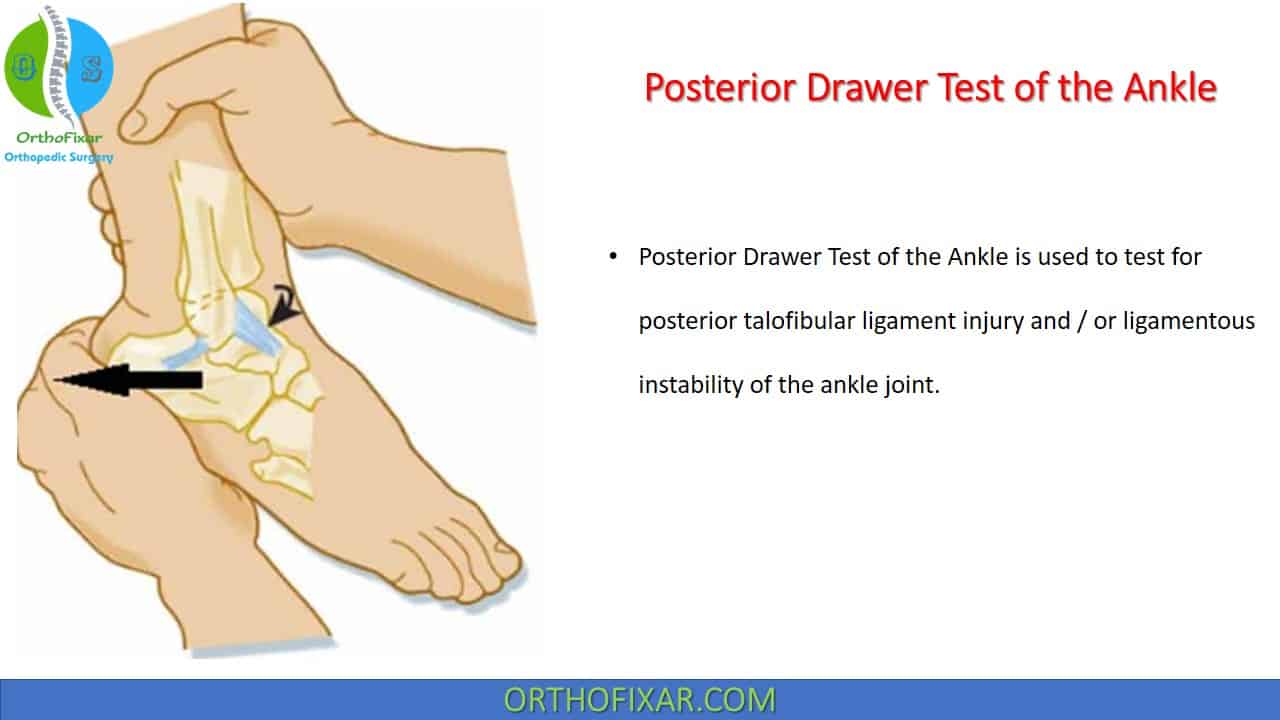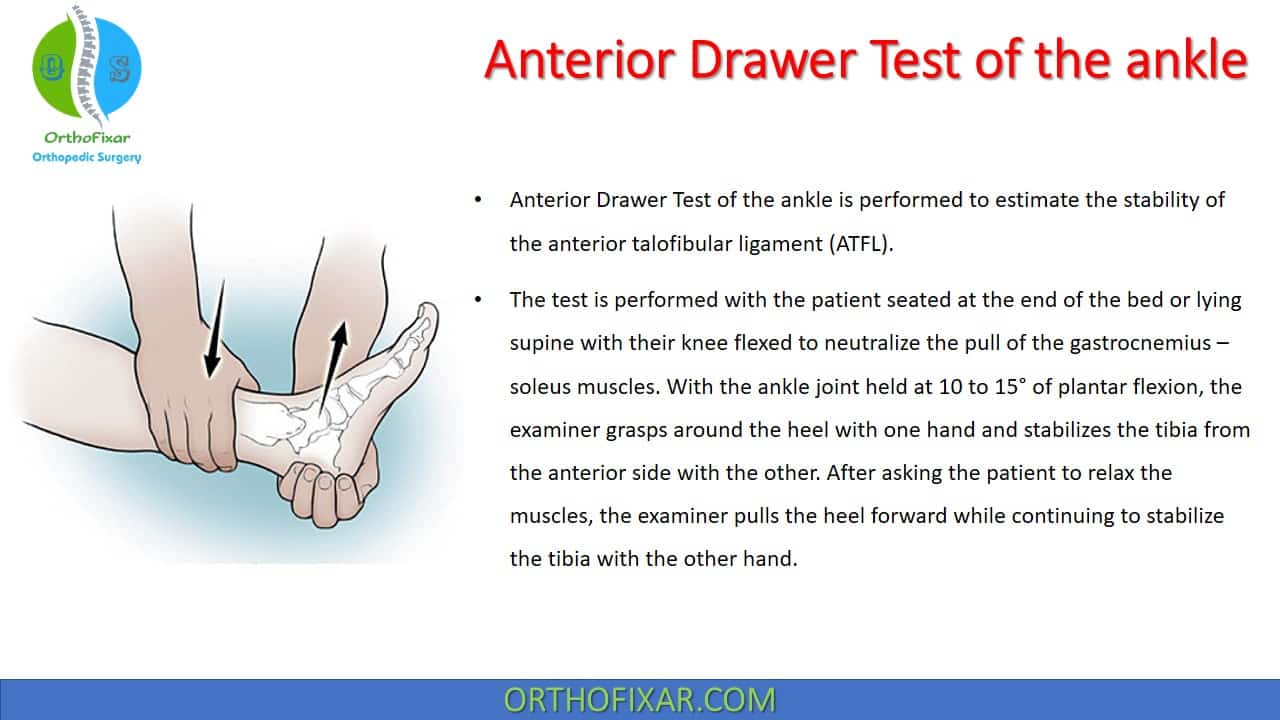Ankle Drawer Test
Ankle Drawer Test - A sensitivity of 52% has been. It is important to be. Additional details can be found on. Want to join the oep community? Web these references provide additional information on the diagnostic accuracy of the anterior drawer test for ankle ligament injuries and its use in clinical practice. High ankle sprain & syndesmosis injuries are traumatic injuries that affect the distal tibiofibular ligaments and most commonly occur due to sudden. Web anterior drawer test ankle | inversion trauma | ankle sprain. Web test competency by anterior drawer in 20° of plantar flexion and compare to uninjured side. The contribution of the lateral. Web the anterior drawer test checks the health of the anterior talofibular ligament (atfl), a key ligament that helps keep the ankle joint stable. Web ankle anterior drawer test accuracy. Web ankle sprains involve an injury to the atfl and cfl and are the most common reason for missed athletic participation. Web the anterior drawer test checks the health of the anterior talofibular ligament (atfl), a key ligament that helps keep the ankle joint stable. Web these references provide additional information on the diagnostic accuracy of the anterior drawer test for ankle ligament injuries and its use in clinical practice. Frost and hanson 7 described the posterior drawer test using the same patient and clinician positioning as that used for the anterior drawer test. It is important to be. Forward shift of more than 8 mm on a lateral radiograph is considered diagnostic for an. Web enroll in our online course: Biomechanical evaluation of the anterior drawer test: Web test competency by anterior drawer in 20° of plantar flexion and compare to uninjured side. Web enroll in our online course: For this test, the examiner stabilizes the patient's lower leg with one hand, puts the. Web the anterior drawer test checks the health of the anterior talofibular ligament (atfl), a key ligament that helps keep the ankle joint stable. Web anterior drawer has sensitivity of 86 percent and specificity of 74 percent for a. Web anterior drawer has sensitivity of 86 percent and specificity of 74 percent for a diagnostic test of 160 patients with an inversion ankle sprain when compared to an arthrogram. The patient lies supine with the foot relaxed. For this test, the examiner stabilizes the patient's lower leg with one hand, puts the. Web the painful conditions of the ankle. Web the anterior drawer test checks the health of the anterior talofibular ligament (atfl), a key ligament that helps keep the ankle joint stable. Web test competency by anterior drawer in 20° of plantar flexion and compare to uninjured side. Web the painful conditions of the ankle and foot are very common presentations and most commonly caused by trauma or. The contribution of the lateral. Web ankle anterior drawer test accuracy. Web the anterior drawer test is a physical exam to diagnose acl tears. Web test competency by anterior drawer in 20° of plantar flexion and compare to uninjured side. Web instability after ankle sprains, particularly lateral sprains, is assessed by the anterior drawer test. Additional details can be found on. Web instability after ankle sprains, particularly lateral sprains, is assessed by the anterior drawer test. The patient lies supine with the foot relaxed. Web test competency by anterior drawer in 20° of plantar flexion and compare to uninjured side. For this test, the examiner stabilizes the patient's lower leg with one hand, puts the. A sensitivity of 52% has been. Frost and hanson 7 described the posterior drawer test using the same patient and clinician positioning as that used for the anterior drawer test. Web these references provide additional information on the diagnostic accuracy of the anterior drawer test for ankle ligament injuries and its use in clinical practice. Want to join the oep. Web detailed information can be found on the knee to wall test page. Web the anterior drawer test checks the health of the anterior talofibular ligament (atfl), a key ligament that helps keep the ankle joint stable. Treatment usually includes a period of immobilization. The examiner stabilizes the tibia and fibula, holds the patient’s foot in 20° of. Web ankle. Web ankle anterior drawer test accuracy. Biomechanical evaluation of the anterior drawer test: High ankle sprain & syndesmosis injuries are traumatic injuries that affect the distal tibiofibular ligaments and most commonly occur due to sudden. Web the prone anterior drawer test of the ankle is an orthopaedic test used to assess the integrity of the lateral collateral ligaments of the. Treatment usually includes a period of immobilization. Web the anterior drawer test is a physical exam to diagnose acl tears. Want to join the oep community? Web the painful conditions of the ankle and foot are very common presentations and most commonly caused by trauma or injury related to sport activities. Web detailed information can be found on the knee. The contribution of the lateral. High ankle sprain & syndesmosis injuries are traumatic injuries that affect the distal tibiofibular ligaments and most commonly occur due to sudden. Treatment usually includes a period of immobilization. A sensitivity of 52% has been. Web anterior drawer test ankle | inversion trauma | ankle sprain. Web these references provide additional information on the diagnostic accuracy of the anterior drawer test for ankle ligament injuries and its use in clinical practice. The anterior drawer test is a beneficial test to perform in a patient following an inversion ankle sprain (injury to the lateral collateral ligaments). Web anterior drawer has sensitivity of 86 percent and specificity of 74 percent for a diagnostic test of 160 patients with an inversion ankle sprain when compared to an arthrogram. Web the prone anterior drawer test of the ankle is an orthopaedic test used to assess the integrity of the lateral collateral ligaments of the ankle viz: Web ankle anterior drawer test accuracy. The patient lies supine with the foot relaxed. Web test competency by anterior drawer in 20° of plantar flexion and compare to uninjured side. Web detailed information can be found on the knee to wall test page. Frost and hanson 7 described the posterior drawer test using the same patient and clinician positioning as that used for the anterior drawer test. In particular, it prevents the talus bone. For this test, the examiner stabilizes the patient's lower leg with one hand, puts the. Web anterior drawer test ankle | inversion trauma | ankle sprain. A sensitivity of 52% has been. High ankle sprain & syndesmosis injuries are traumatic injuries that affect the distal tibiofibular ligaments and most commonly occur due to sudden. Web the painful conditions of the ankle and foot are very common presentations and most commonly caused by trauma or injury related to sport activities. The examiner stabilizes the tibia and fibula, holds the patient’s foot in 20° of.Posterior drawer test for the ankle YouTube
Positive Anterior Drawer TestAnkle Exam YouTube
Ankle Posterior Drawer Test YouTube
Anterior Drawer Test of Ankle YouTube
Ankle Anterior Drawer Test YouTube
Special Test Category Ankle & Foot Examination OrthoFixar
Foot & Ankle Anterior Drawer Test (APPA) YouTube
Anterior Drawer Test Of The Ankle
Anterior Drawer Test Of The Ankle
How To Perform Anterior Drawer Test For Ankle? Drawer test, Medical
Want To Join The Oep Community?
Additional Details Can Be Found On.
Web The Anterior Drawer Test Checks The Health Of The Anterior Talofibular Ligament (Atfl), A Key Ligament That Helps Keep The Ankle Joint Stable.
Biomechanical Evaluation Of The Anterior Drawer Test:
Related Post:









